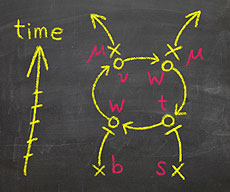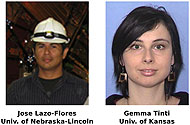Hidden in time loops
 |
In the above reaction, a bottom quark (b) and a strange quark (s) transform into two muons (μ) by way of a loop involving a top quark (t), two W bosons (W), and a neutrino (ν). Part of this loop goes backward in time. |
Many particles created in proton collisions are short-lived, measuring their lives in trillionths of a trillionth of a second. Scientists reconstruct them from the trajectories of their remnants. But some particles are even more transient than that. They live and die entirely within a reaction - their brief existence is just a step in the transformation of the colliding particles into their remnants.
As a bizarre consequence of quantum mechanics, these ephemeral particles can even travel backward in time. Normal particles trace lines through space and time that are always forward in the time direction. A particle in the midst of a collision can actually trace a loop, connecting its birth with its death, but only if it can't be observed.
Consider the diagram above. Two quarks, bottom and strange, collide and result in two muons. To satisfy conservation laws, a top quark, two W bosons and a neutrino must be created and destroyed in a sequence that ends with the last one begetting the first. The fact that the collision had far too little energy to create the mass of a top quark or even a W boson does not make this reaction impossible— it only makes it rare.
With no hard limit on the mass of the participants, anything could be running around the loop, even undiscovered particles and particles that are too massive for the LHC to directly create. These strangers would be noticed by their effect on the probability of the reaction: if there are more particles willing to help a bottom and a strange quark become two muons, it could happen more often.
If only known particles contribute, this reaction would be extremely infrequent— only a few bottom-strange encounters per billion would result in a pair of muons. That just makes it easier to see the effect that new particles would have. It's easier to see a flea riding an ant than a flea riding a horse.
CMS scientists are searching for this kind of reaction with ever-increasing precision. Recently, they published a measurement sensitive to eight parts per billion. While the reaction hasn't been definitively observed yet, this year's dataset should be large enough to see it even if there are no new particles. We are sure to see the ant; time will tell if it has a rider.
—Jim Pivarski
 |
The U.S. physicists pictured above contributed to this analysis as part of an excellent international team of scientists. |
 |
The CMS Communication Group is responsible for both communication among physicists and communication with the public. |
|